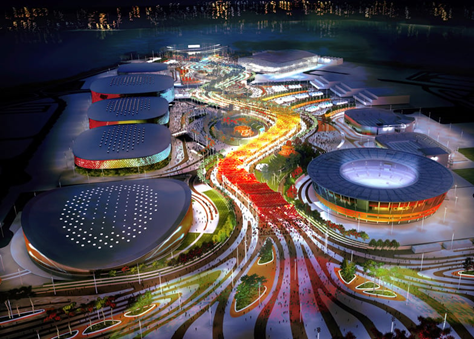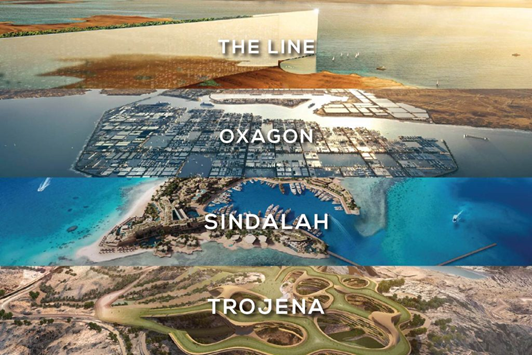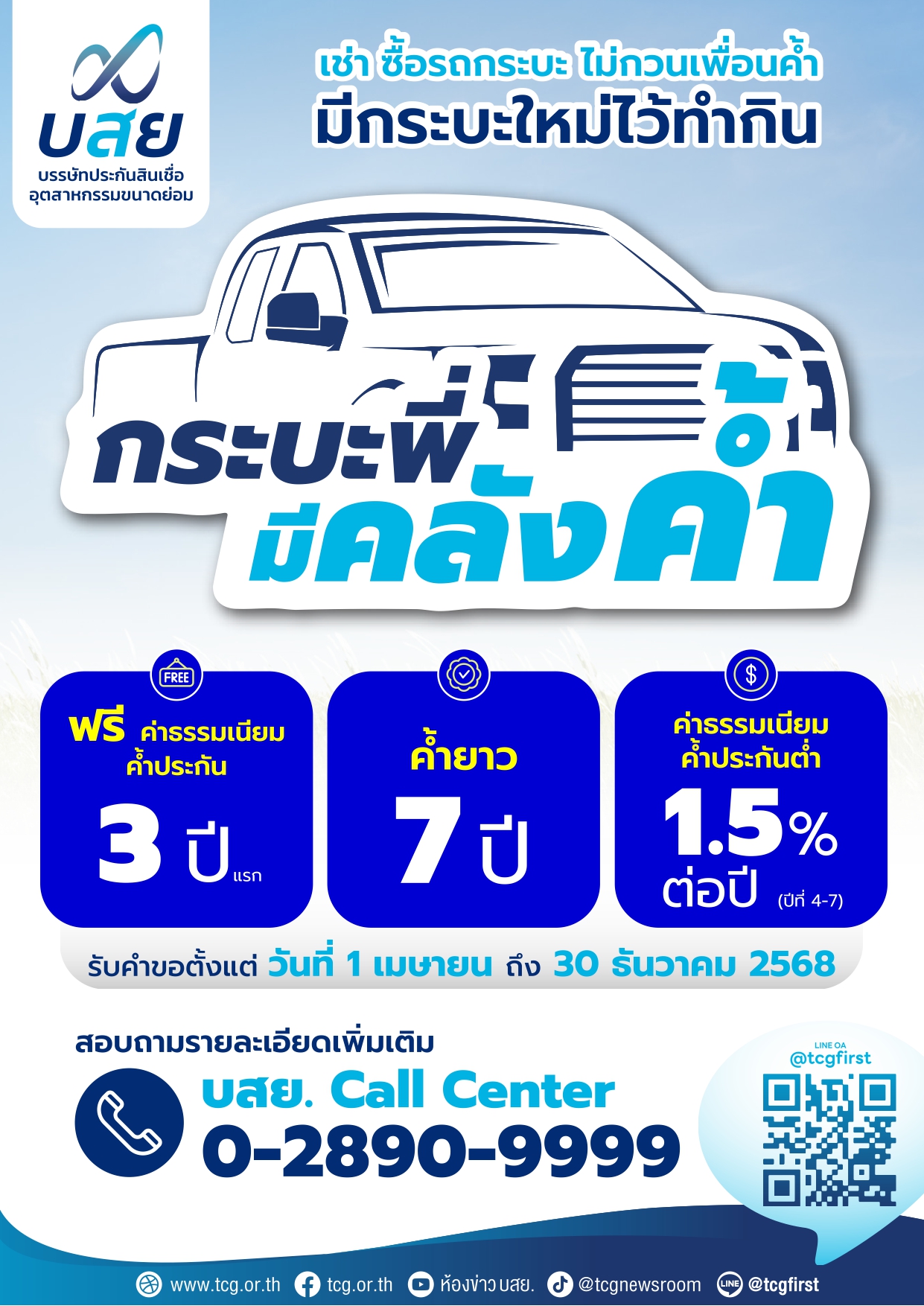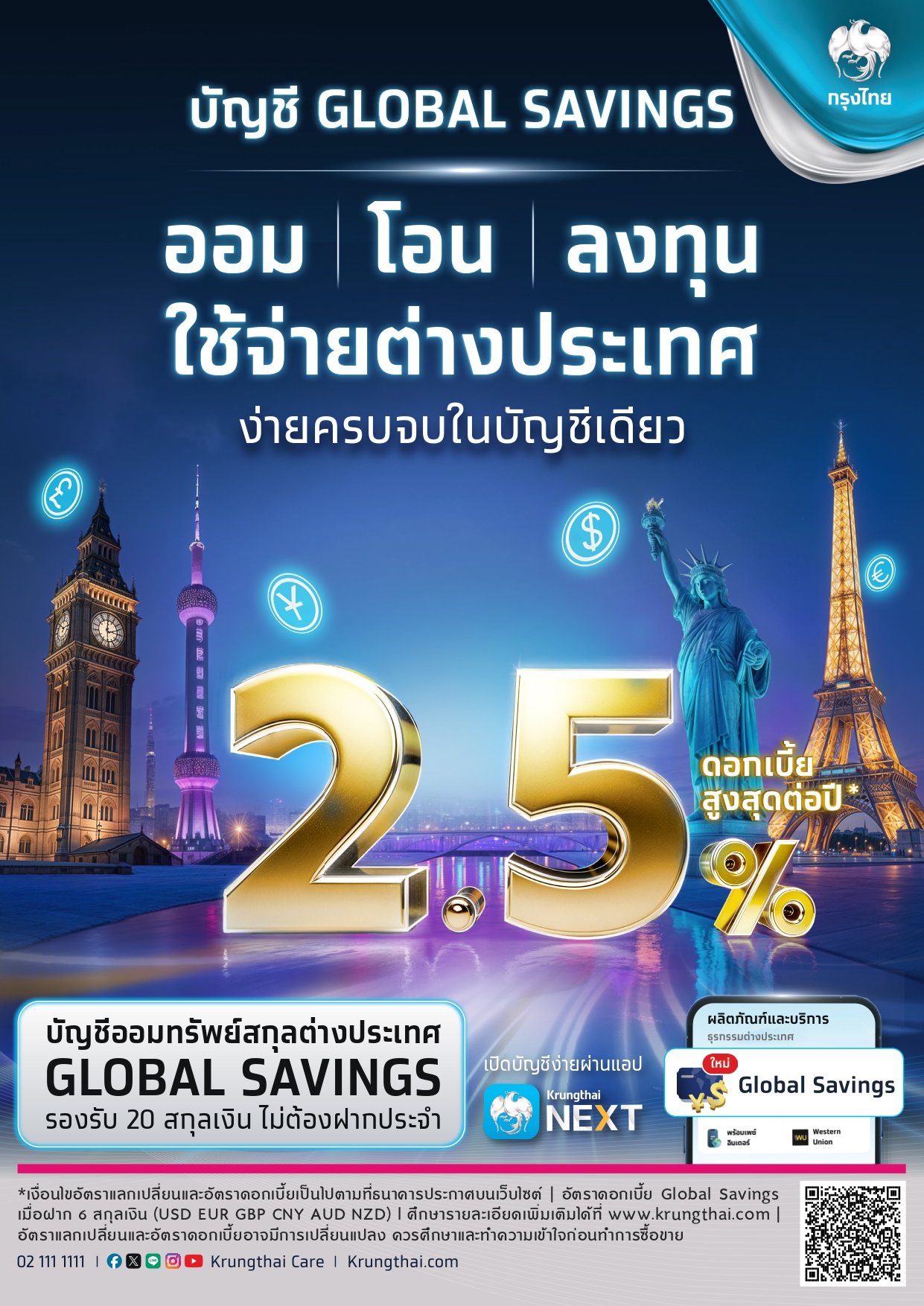By
Chanon Limpasitipon
Senna Lertpisitkul
1. Introduction
Mega projects represent distinctive large-scale infrastructure initiatives often positioned as transformative engines of economic growth. These investments, spanning transportation, energy, digital infrastructure, and urban development, have the potential to stimulate economic activity, enhance connectivity, and attract foreign direct investment (FDI).
However, their execution frequently encounters with challenges, including cost overruns, governance failures, and environmental and social concerns. Economic literature suggests that while such projects can generate long-term productivity gains, their success depends on effective governance, risk management and financial sustainability.
This article examines the role of mega project investments in economic development, evaluating their capacity to act as catalysts for progress or high-risk ventures that could undermine stability and create burdensome.
2. Mega Projects as Game Changers
2.1. Economic Stimulus and Multiplier Effects:
Mega projects contribute to both short-term and long-term economic growth by generating employment opportunities and stimulating demand for construction materials, technology, and services. Infrastructure investments tend to exhibit high fiscal multipliers, meaning they yield economic returns exceeding initial expenditures. Empirical studies have shown that infrastructure investment can increase GDP growth rates, with some projects yielding returns of 1.5 to 2 times the initial investment. The spillover effects extend to various sectors, including logistics, manufacturing, and real estate, further amplifying economic gains.
2.2. Transmission Mechanisms to Economic Growth:
The transmission mechanism of mega projects to economic growth occurs through several key channels such as
- Capital Accumulation: Investment in infrastructure enhances physical capital stock, directly contributing to higher production capacity and GDP expansion.
- Labor Productivity: Improved infrastructure reduces travel time, enhances energy efficiency, and facilitates digital connectivity, allowing firms and workers to operate more productively.
- Private Sector Growth: Reliable infrastructure attracts businesses by lowering operational costs and reducing uncertainties, thereby fostering entrepreneurship and innovation.
- Income Growth and Human Capital Development: Higher wages in construction and related industries contribute to increased household income. Additionally, better infrastructure in healthcare and education enhances human capital accumulation, leading to long-term improvements in productivity and living standards.
- Urbanization and Regional Development: Large-scale infrastructure projects encourage urbanization and balanced regional development. Improved transport networks connect rural areas with urban centers, fostering economic integration and reducing regional income disparities.
- Social Inclusion and Quality of Life Improvements: Infrastructure developments in healthcare, education, and digital connectivity provide broader access to essential services, reducing inequality and enhancing overall well-being.
2.3. Foreign Direct Investment (FDI) and Economic Transformation:
Mega projects, particularly in developing economies, act as key drivers of FDI inflows. By offering attractive investment opportunities to multinational corporations, these projects introduce new technologies and modern management practices, further accelerating economic development. FDI occurs through various means, including direct capital investment, mergers and acquisitions, and joint ventures, providing crucial funding and expertise for complex infrastructure projects.
3. Mega Projects as Gambles
3.1. Cost Overruns, Budget Mismanagement, and Debt Burdens:
One of the most persistent risks associated with mega projects is their tendency to exceed budgetary allocations. Large-scale infrastructure projects frequently experience cost escalations ranging from 20% to over 100% of initial estimates. These overruns place substantial fiscal burdens on governments, leading to unsustainable debt accumulation and potential credit downgrades. For instance, the Eurotunnel project, linking the UK and France, saw costs soar by 80%, resulting in significant financial distress.
3.2. Political and Economic Uncertainties:
Mega projects often span multiple political cycles, making them susceptible to shifts in government priorities and policy directions. Additionally, macroeconomic fluctuations, such as currency depreciation and inflation, can erode financial viability. Corruption and rent-seeking behavior further exacerbate inefficiencies, undermining public trust and investor confidence. Countries with weak institutional frameworks are particularly vulnerable to project failures due to governance lapses.
3.3. Environmental and Social Externalities:
Large-scale projects can have profound ecological and social consequences. Infrastructure expansion often necessitates land acquisition, resulting in displacement of communities and loss of biodiversity. Environmental degradation, including deforestation and carbon emissions, can offset the economic benefits of such investments if sustainability considerations are not integrated into planning and execution. The Three Gorges Dam in China, for example, displaced over 1.3 million people and caused extensive ecological disruptions.
4. Case Studies Across the World
4.1. Rio 2016 Olympics
Hosting the Olympics is considered a very prestigious honor to all countries due to the positive impacts it creates for the host countries. In 2016, Brazil became the first South American country to host the Olympics and convinced the Olympic committee of their confidence in their economic status, being able to set aside the estimated 14.4 billion USD needed for the event. On top of this, the construction of facilities would be easier for Brazil due to past events such as the 2007 Pan American Games or the 2014 World Cup, thus allowing them to reuse and renovate different types of venues such as stadiums.
Out of the estimated 14.4 billion USD needed, the actual games of each event are projected to cost less than 3 billion USD. However, Brazil’s Public Authority for Olympic Legacy stated a year after the event that the total had been around 5 billion USD. Yet, this amount did not include government spending, which totaled to about 13.1 billion USD to construct facilities such as new subway lines, a doping laboratory, and cleanup of polluted Guanabara Bay.

With these newly built facilities, not only did it attract over 11,000 athletes and 7.5 million spectators, it provided local Brazilians many job opportunities ranging from high to low skilled, leading to a huge amount of economic growth; accounting for 82% of Rio’s local economy. Due to this, the income inequality within Rio was reduced, with the income of the poorest 5% growing up to 29.3% compared to the richest 5% growing at 19.96%.
Moreover, this project attracted further FDI from Transnational Companies (TNCs) from around the world as this event was seen to be profitable for all. Examples of TNCs including
- Toyota (motor cooperation) in supporting the sustainability goals of the Olympic Movement, ensuring it adopts the most sustainable, efficient mobility solutions for transportation during the event.
- Coca-Cola (beverage company) in marketing campaign #That’sGold on global television featuring famous athletes aimed to celebrate with fans, which helped Coca-Cola and the Olympics to obtain 500 million impressions. They also offered visually stunning activation, including ice cold Coca-Cola served in aluminum bottles in celebration of the Torch Relay, which increasingly raised awareness of the event occurring.
- Atos (Worldwide IT Partner) in providing complex IT systems and solutions which helped increase efficiency with the distribution of data, such as displaying results in less than half a second. Moreover, the first use of ‘Cloud’ at an Olympics game reduced the use of servers by 75% thus reducing further costs and energy consumption.
- Dow (Official Chemistry Company) in building comprehensive carbon mitigation programs, which helped address the problems of climate change and increase the sustainability of the event. They also helped Transforma expand to seven additional cities, providing over 180,000 students with training opportunities, which may most likely lead to future economic growth.
With the help of FDI from these TNCs, not only do the TNCs generate further revenue from the global exposure of their company, but it had also allowed the event to become much more cost efficient and globally accepted. From this event, Brazil’s total tourism also increased by 6.2% with their GDP per capita being 7.5% higher than it would have been without this mega project. This shows how the 2016 Brazil Olympic games were successful in enhancing economic growth in less developed areas with the help of FDI and global recognition
Key Strengths that make this project successful are
- Geographic location: Rio de Janeiro provided a stunning backdrop with its natural beauty and iconic landmarks like Sugarloaf Mountain and Copacabana Beach, enticing tourists to want to come.
- Legacy: Success of 2014 football world cup showed the world that Brazil can host huge events like the world cup (They also already heavily invested in infrastructure, which was redeveloped and renovated thus did not cost as much).
- FDIs: An Olympic event will bring lots of recognition to many brands due to it being a global event, thus lots of TNCs will invest in the project which helped fund it.
Some factors that might view this project as unsuccessful are
- Economic cost: High government spending, thus creating an opportunity cost, as government investment could have been spent on alternative sectors such as education or healthcare.
- Ineffective infrastructure: After the Olympic games, the venues struggle to attract operational funding, meaning that the Brazilian government had to shut them down. Venues included the Marcana stadium, or swimming pools used for the events.
- Social Legacy: Some areas such as Porto Maravilha became popular to tourist, which in time led the gentrification, causing land/house prices to rise tremendously, forcing locals with low income to move out.
4.2. The Neom, Saudi Arabia
The Neom in Saudi Arabia is a mega project currently being constructed, which serves as a prototype for an automated smart city of the future. They plan to create a city where all equality is considered such as healthcare and education, whilst trying to develop the next-gen industries for the upcoming digital economy. This project is being led by Chief Executive Officer Nadhim Al-Nasr who claims the fund is contributing 500 billion USD to the scheme, also with the funding by the Public Investment Fund of Saudi Arabia. The proposed project is anticipated to generate substantial economic benefits for Saudi Arabia. It is projected to create approximately 380,000 job opportunities, thereby contributing to employment growth and supporting labor market development. In terms of macroeconomic impact, the project is expected to add 48 billion USD to GDP, reinforcing national economic diversification efforts in line with Vision 2030 objectives. Additionally, it is estimated to contribute 1.3 trillion USD to the Saudi stock market, potentially enhancing capital market depth and liquidity. The project also offers an expected return on investment (ROI) of 13 – 14% by 2030, signaling strong financial viability and investor appeal. Furthermore, it is likely to stimulate foreign direct investment (FDI) through increased participation by international companies engaged in supplying construction materials, offering specialized services, and forming strategic partnerships with domestic firms. This influx of FDI is poised to bolster technological transfer, improve industry standards, and support sustainable economic growth.

The Neom consists of four different projects:
- The Line: Comprised of a series of interconnected modules, reaching 500m high and 170km in length. The Line plans to accommodate 9million people and will be built on a footprint of just 34 square kilometers, thus meaning reduced infrastructure footprint and higher efficiencies within the area. Civilians living within the Line will have access to facilities such as a high-speed railway with a 20 minutes transit.
- Oxagon: An Octagon port city that will be built on the Red Sea, far south of the Neom Region. This project utilizes and will specialize in advanced and clean industries due to their strategic location next to the Red Sea, providing them with renewable energy sources such as water, wind, and sunlight. By doing so, Saudi Arabia will be able to diversify the country’s economy and reduce reliance on oil.
- Sindalah: A luxury island resort within the Red Sea, aimed to be a yachting community. This island is 840,000 square meters, and will have 86 berth marinas and numerous hotels, which help bring in tourists from all over the world whilst focusing on conserving the area’s natural beauty. The development is expected to generate 3,500 jobs in the tourism, hospitality, and leisure sectors.
- Trojena: Located 50km from the coast of the Gulf of Aqaba, with an area of nearly 60 square km. According to the Saudi Press Agency, this new tourist destination will include a ski village, ultra luxury resorts, and many restaurants.
Currently, which the success of this mega project, Neom has made many contracts with TNCs from around the world and received FDI to help make this project become reality. Examples of FDI including
- Siemens: A global technology powerhouse with expertise in various sectors, including energy, electrification, automation, and digitalization. They focus on providing innovative and sustainable solutions for energy generation and distribution, whilst developing smart infrastructure/digital systems for the city
- ABB: Leading company in electrification, robotics, industrial automation, and power technologies. Focused on advanced energy solutions, smart grid technologies, and industrial automation systems to support the city’s energy needs and sustainable development.
- Bechtel: One of the largest construction and engineering companies globally, known for handling complex infrastructure projects. They help leverage massive construction and development plans, including the design and implementation of various buildings, transportation networks, and other essential infrastructure
- Soft Group: Japanese multinational conglomerate, who signed a Memorandum of Understanding (MoU) with the Saudi government to collaborate on technological innovations and investment opportunities in NEOM.
- McLaren: In 2022, NEOM announced a strategic partnership with McLaren Racing to become the title partner of the NEOM McLaren Formula E Team and NEOM McLaren Extreme E Team racing teams, bringing two all-electric race series’ together for the first time under the banner of ‘NEOM McLaren Electric Racing’.
- ACWA: A Saudi utility company that made a contract with NEOM worth $500m to develop solar farms with a capacity of 2,000 megawatts. These solar farms will help this mega reach their sustainability goal.
With the help of these FDI’s and contracts, The Neom project is currently being developed and is seen to succeed by their expected date of 2030. With this project, Saudi Arabia’s GDP will continue to rise, especially due to lower unemployment rates and a more diverse economic sector for workers of al skills.
Key Strengths that make this project successful:
- Key investors: Having TNCs from different sectors such as technology, industry, sustainability all allow the NEOM project to be as efficient as possible in terms of production and construction, and in bringing further investors into the project.
- Geographical factors: By being in the Kingdom of Saudi Arabia, they have access to all types of renewable energy and natural resources including wind, water, solar, oil and even processes such as salinization from the ocean for sustainability.
- Location: Big open deserts allow easy construction and cheaper land as it is not densely populated. On top of this, there are less ethical concerns in terms of eviction or destruction of past infrastructure that may intervene with the project.
Some factors that might causing this project to be unsuccessful are
- Livability: Since the Neom is in a rural area, it may be difficult to retain over a long period of time due to the challenges of maintenance, which may include transporting raw materials for construction.
- Human rights: Indigenous tribes within these rural areas such as the Huwaitat tribe are being relocated. If any resisting occurs, threats and punishments will occur.
- Financial Risk: Since the PIF is the biggest funder for the NEOM project, if they chose to back out of the project, it will be unsuccessful.
5. Thailand’s Potential for Mega Project Development
Thailand has the opportunity to leverage mega projects for economic transformation, particularly through FDI. Key considerations include:
5.1. Strategic Investment in Infrastructure:
Projects such as the Eastern Economic Corridor (EEC) and Land Bridges efforts could significantly boost economic activity, attract FDI, and create employment opportunities. By focusing on high-value sectors like advanced manufacturing, digital economy, and sustainable tourism, Thailand can enhance its competitive position in the global economy.
5.2. Balanced Growth and Social Impact:
Ensuring that mega projects benefit local populations, rather than displacing them, is crucial for long-term success. Community engagement, fair compensation for land acquisition, and inclusive development planning can help mitigate social tensions and ensure broader distribution of economic benefits.
5.3. Sustainability and Innovation:
Thailand’s focus on sustainability and innovation offers a strategic advantage in attracting foreign direct investment (FDI). By advancing eco-friendly infrastructure, smart cities, and high-tech industrial zones, Thailand positions itself as a leader in sustainable development. The use of the Thai ESG Fund and ESG Extra Fund further reinforces its commitment to green investment, appealing to global investors seeking climate-resilient opportunities and supporting long-term, sustainable economic growth.
5.4. Public-Private Partnerships (PPP):
Encouraging collaboration between the government and the private sector can provide additional funding sources, risk-sharing mechanisms, and access to global expertise. Well-structured PPP frameworks can enhance project efficiency, improve service delivery, and ensure financial sustainability over the long term.
6. Conclusion
Mega projects can serve as pivotal drivers of economic transformation when executed with strategic foresight, sound governance, and financial prudence. While successful initiatives contribute to infrastructure-led growth, poorly managed projects risk exacerbating fiscal vulnerabilities and socio-environmental tensions.
For Thailand and other emerging economies, the challenge lies in balancing ambition with sustainability, ensuring that mega projects function as genuine game changers rather than speculative gambles. By integrating FDI, prioritizing sustainability, and maintaining public trust, Thailand can maximize the positive impacts of mega projects and secure long-term prosperity.
By learning from global case studies—both successes and failures—policymakers can develop more robust approaches to mega project planning, financing, and implementation. With proper governance mechanisms, transparent procurement processes, and comprehensive risk management strategies, mega projects can indeed become powerful catalysts for inclusive and sustainable economic development.
References
Adesanya, A. (2020, June 16). Global foreign direct investment to drop 40%—UN. Business Post Nigeria. www.businesspost.ng/world/global-foreign-direct-investment-to-drop-40-un/
Aschauer, D. A. (1989). Is public expenditure productive? Journal of Monetary Economics, 23(2), 177-200. https://doi.org/10.1016/0304-3932(89)90047-0
Beca. (n.d.). Rio 2016 crowd modelling. www.beca.com/what-we-do/projects/transport-and-infrastructure/rio-2016-crowd-modelling
Brito, R., & Wade, S. (2017, June 15). AP analysis: Rio de Janeiro Olympics cost $13.1 billion. AP News. www.apnews.com/general-news-d1662ddb3bae4d2984ca4ab65012be78
Douglas, S. (n.d.). Lasting impact of the Rio Olympic Games. University of Illinois at Urbana-Champaign.
Flyvbjerg, B. (2014). What you should know about megaprojects and why: An overview. Project Management Journal, 45(2), 6-19. https://doi.org/10.1002/pmj.21409
Flyvbjerg, B., Bruzelius, N., & Rothengatter, W. (2003). Megaprojects and risk: An anatomy of ambition. Cambridge University Press.
Frearson, A. (2013, September 3). Rio 2016 Olympic Park by AECOM. Dezeen. www.dezeen.com/2013/09/03/rio-2016-olympic-park-by-aecom/
Gleick, P. H. (2009). Three Gorges Dam Project, Yangtze River, China. The World’s Water 2008-2009: The Biennial Report on Freshwater Resources, 139-150. https://www.researchgate.net/publication/265238648_Three_Gorges_Dam_Project_Yangtze_River_China
Hurley, J., Morris, S., & Portelance, G. (2018). Examining the debt implications of the Belt and Road Initiative from a policy perspective. Center for Global Development Policy Paper 121. https://www.cgdev.org/publication/examining-debt-implications-belt-and-road-initiative-policy-perspective
Ikiz, S. U. (2023, January 18). NEOM released Saudi Arabia mega projects’ first progress video. Parametric Architecture. www.parametric-architecture.com/neom-released-saudi-arabia-mega-projects-first-progress-video/
International Olympic Committee. (2016). Marketing report: Rio 2016.
International Olympic Committee. (2017, April 28). Olympic Games Rio 2016 – economic legacy. www.olympics.com/ioc/news/olympic-games-rio-2016-economic-legacy
International Olympic Committee. (2021, July 15). New independent study confirms games provided significant economic benefit to Rio de Janeiro – Olympic News. www.olympics.com/ioc/news/new-independent-study-confirms-games-provided-significant-economic-benefit-to-rio-de-janeiro
NEOM. (2022). OXAGON. www.neom.com/en-us/regions/oxagon
NEOM. (2022). The Line. www.neom.com/en-us/regions/theline
NEOM. (2022). TROJENA. www.neom.com/en-us/regions/trojena
NEOM. (n.d.). NEOM brand partners. www.neom.com/en-us/our-business/partners
NEOM. (n.d.). Sindalah. www.neom.com/en-us/regions/sindalah
Richter, A., Santos, V.-J., & Schuring, M. (2023). Unlocking financial opportunities: Evaluating urban infrastructure’s economic impacts. World Bank Blogs. www.blogs.worldbank.org/en/sustainablecities/unlocking-financial-opportunities-evaluating-urban-infrastructures-economic
Tanzi, V., & Davoodi, H. R. (1998). Roads to nowhere: How corruption in public investment hurts growth. IMF Economic Issues No. 12. International Monetary Fund. https://www.imf.org/external/pubs/ft/issues12/issue12.pdf
Trendafilova, S., Graham, J., & Bemiller, J. (2018). Sustainability and the Olympics: The case of the 2016 Rio Summer Games. 1 Journal of Sustainability Education. www.susted.com/wordpress/content/sustainability-and-the-olympics-the-case-of-the-2016-rio-summer-games_2018_01/
UNCTAD. (2020). World Investment Report 2020: International production beyond the pandemic. United Nations Conference on Trade and Development. https://unctad.org/webflyer/world-investment-report-2020
Xiao, Y., D’Angelo, D., & Lê, N. T. (2020). Infrastructure investment and the sustainable development goals. In Well spent: How strong infrastructure governance can end waste in public investment (pp. 71-92). International Monetary Fund. https://doi.org/10.5089/9781513511818.071.ch004



Chanon Limpasitipon
Economist (Professional Level)
Author

Senna Lertpisitkul
Intern
Author
